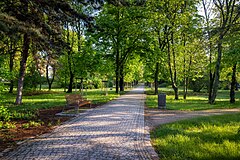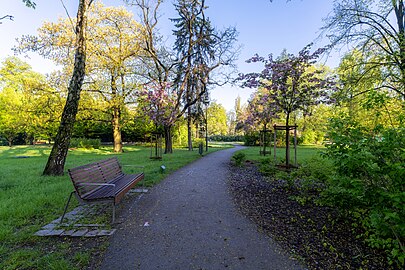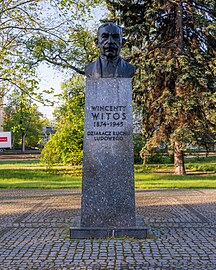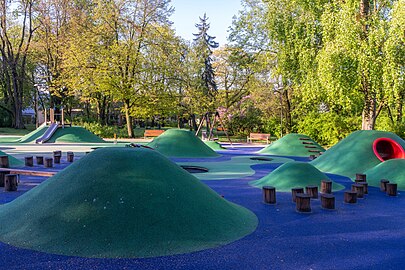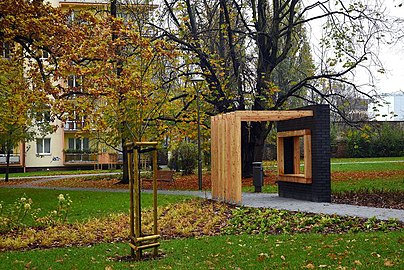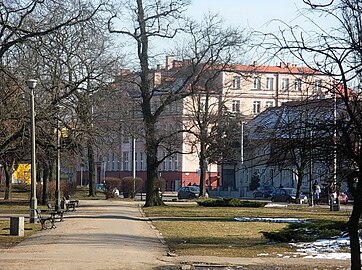|
Wincenty Witos Park, Bydgoszcz
Wincenty Witos Ludowy Park is a 6.42 hectares (15.9 acres) urban park in downtown district of Bydgoszcz, Poland. LocationThe park is located in downtown Bydgoszcz, surrounded by the following streets:
The area has a roughly rectangle shape, 250 metres (820 ft) by 275 metres (902 ft) and stands between the Youth Palace (Polish: Pałac Młodzieży) at 27 Jagiellońska street and the Basilica of St. Vincent de Paul. It has been named after Wincenty Witos (1874-1945), a Polish politician, activist of the Peasant movement and three times Prime Minister. HistoryProtestant cemeteryThe Ludowy Park (People's Park) was established on the site of a Protestant cemetery.[1] The latter dated back to 1778 and was the oldest and the largest in Bydgoszcz.[2]  The area for the cemetery, purchased from the Grodztwo estate, was later expanded and eventually covered a surface of 6.5 hectares (16 acres). In 1838, a residential house for the administrator was erected on the premises, where a separate room was used as a morgue. In 1884, a chapel was built and in 1898, a massive brick fence. That latter survived until the liquidation of the cemetery.[2] Four forged gates opened onto the streets: two onto Jagiellońska and two onto Markwarta. Inside the site, 8 metres (26 ft) wide roads, flanked with lindens, ran from the gates, leading to the chapel located on a large central square. A network of paths beaming out from the center divided the cemetery into quarters.  The place was teeming with greenery:[1]
In 1938, a survey listed 66 species of trees and shrubs in the cemetery. Although many people of merit, mainly of German nationality, found their resting place here, in 1927, Polish authorities decided the liquidation of the cemetery, pleading in the one hand a significant reduction of Evangelicals in the city (after the recreation of Polish state) and on the other hand the plan to rebuild the surrounding streets for sanitary reasons. The municipal decision was appealed against to the Supreme Administrative Tribunal which in 1934, denied the will of the municipal authorities.[3] After the end of WWII and the liberation of Bydgoszcz in 1945, the old cemetery was definitively closed. Protestants were offered plots at the Evangelical-Augsburg cemetery in Zaświat street.[2] The eventual liquidation of the old gravesite, started in 1946, was completed in 1953. The last exhumation to be moved to the Zaświat street site was held in 1956.[1] During the liquidation, many artifacts were lost or destroyed: tombstones, sculptures, reliefs, catacombs. It included family tombs and resting place of famous personages: Theodor Gottlieb von Hippel the Younger (1775-1843), Carl and Wilhelm Blumwe, city successful entrepreneurs, who saw only their grave sculpture preserved (a copy of Bertel Thorvaldsen's statue of Christ the Savior) and moved to the front square of the Lutheran Church of the Savior in Bydgoszcz. The work piece is still standing nowadays. Ludowy ParkAs the cemetery closed, a municipal urban park named Ludowy Park (People's Park) was established in its very place, boasting the old greenery left from the necropolis. In 1956, an acoustical shell was erected on the premises, with facilities for band performances. Afterwards were constructed around the area:[2]
 On June 3, 1984, on the initiative of the United People's Party, the park was named after Polish politician Wincenty Witos. For the occasion, a bust of the activist was unveiled: it had been realized by Witold Marciniak and funded by the peasants from the Bydgoszcz Voivodeship. Furthermore, between this monument and the concert shell, a circular fountain was built.[2] In 2007,several elements of the park were renovated (park alleys, concert shell) and the greenery was restored. During these works, a monument commemorating the ancient Protestant cemetery was unveiled on April 24, 2007. It consists of a black granite, placed in the south-eastern corner of the compound, which bears the following inscription:
Characteristics The park is equipped with a network of paths with benches, tennis courts and children playgrounds. In July 2009, the-then largest mural in the country was created near the park. After a week of work, nine young artists from Bydgoszcz, Olsztyn and Łódź realized a painting depicting Peter Pan under a tree with fairy-tale characters.[4] Outdoor concert shellThe now gone open-air theatre was built in 1956, as a replacement of an amphitheater erected in nearby Kazimierz Wielki Park in 1946, to house events and concerts organized on the occasion of the 600th anniversary of Bydgoszcz's founding.[5] In the 1980s, the interest in this concert stage decreased, with the competition of another open-air arena set up at the Zawisza stadium.  A survey carried out by experts in December 2016, highlighted the poor technical condition of the facility, down to its foundations. The prohibitive revitalization costs (3 to 4 million PLN) led to its closure,[6] which happened in December 2017.[7] Natural valuesThe park is mainly wooded by native tree species: maples, lindens, hornbeams and oaks.[8]One can mention in particular a conical variety of common hornbeam, a common catalpa and a Honey locust.[9] Along the avenue are planted, among others, Norway maple trees, horse chestnuts, black pines, blue spruces Lombardi poplars.[10] Polish Natural Monuments[11] In the park and its close surroundings are identified five specimens of Polish Natural Monuments.
RevitalizationIn 2017, a decision was made to revitalize the park and meliorate the facility (setting up rainwater collection devices) in a 8 million PLN project.[15] In 2018, preparation works encompassed the removal of more than 60 trees (mainly maples, honey locusts, black locusts and chestnut trees)[16] which, after the 2017 storms, presented bad conditions or were endangering public safety.[17] Revitalization scheme started on March 21, 2018.[18] It soon appeared that an immense number of non-exhumed bodies from the ancient Protestant cemetery were still present underground, at an average depth of 90 centimetres (35 in): data estimated that 80 000 tombs were still there.[19] As a consequence, several enhancements planned in the project were put aside, such as the large-scale children recreational area and the rainwater collection tanks.[20] In 2019, the playground was recreated, but with much less elements than initially thought of.[21] The first stage of the park's revitalization, covering an area of 4.1 ha (excluding tennis courts), was completed at the end of October 2019.[22] Due to the fact that the Witosa Park will be a place of rest and reflection, the concert shell will not be reconstucted there. On the other hand, the large circular fountain, dismantled in March 2021,[23] will be recreated in the future, after a competition to be launched soon,[24] together with the second stage of the revitalization programme. Gallery
See alsoWikimedia Commons has media related to Wincenty Witos Park in Bydgoszcz.
References
Bibliography
|
||||||||||||||||||||||||||||||||||||||||||||||||||
